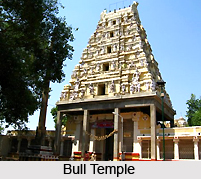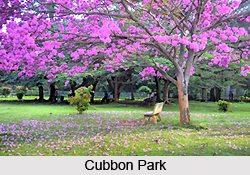 Tourism in the city of Bengaluru, Karnataka is quite well developed. Large number of tourists visits Bengaluru throughout the year especially because of the salubrious climate which can be enjoyed amidst the lush greenery of the city. It can also be said that Bengaluru is a haven for the tourists as it has plenty of modern wonders, flourishing boulevards, places of historical interest, bustling shopping complexes and a lot more. The beautiful parks and the tree-lined roads of Bengaluru offer solace to the tourists in the true sense. Bengaluru, in fact, has the capacity to blend nature with the growing technology in a very wonderful manner and that is the reason the city stands out from others.
Tourism in the city of Bengaluru, Karnataka is quite well developed. Large number of tourists visits Bengaluru throughout the year especially because of the salubrious climate which can be enjoyed amidst the lush greenery of the city. It can also be said that Bengaluru is a haven for the tourists as it has plenty of modern wonders, flourishing boulevards, places of historical interest, bustling shopping complexes and a lot more. The beautiful parks and the tree-lined roads of Bengaluru offer solace to the tourists in the true sense. Bengaluru, in fact, has the capacity to blend nature with the growing technology in a very wonderful manner and that is the reason the city stands out from others.
Pilgrimage Tourism in Bengaluru
The places of religious interest in the city are the Bull Temple, the Iskcon Temple, Karnataka and the St. Marks Cathedral. The Bull Temple of Bengaluru is dedicated to Nandi, which is a holy bull to the Lord Shiva. It is one of the oldest temples of the city and its specialty is that it has been made from a single piece of granite. The temple closely reflects the Dravida style architecture. The annual festival Kallekai parse is celebrated in the temple in the months of November and December when a lot of people visit the temple and participate in the festival. The bull in the temple measures 4.57 meters in height and 6.10 meters in length.
An underground temple is also present in the complex of the Bull Temple and is known as the Sri-Gavi Gandadhareshwara Temple. A special charm is associated with this temple on the day of Makar Sankranti. It is true that celebrations accompanied with music are an integral part of the Bull Temple but the occasion of Shivaratri is celebrated with special reverence in the temple. The entry to the temple is free and the timings are from six in the morning till eight in the evening.  The Iskcon temple of Bengaluru is one of the splendid temple structures in the city. It has wonderfully blended the spirit of modernity with the traditional south Indian architecture. The other structures which are present in the temple complex are a multi vision cinema theatre, a Vedic library and it also provides accommodation to the devotees, the brahmacharis and also to those who take short term courses in Vedic literature.
The Iskcon temple of Bengaluru is one of the splendid temple structures in the city. It has wonderfully blended the spirit of modernity with the traditional south Indian architecture. The other structures which are present in the temple complex are a multi vision cinema theatre, a Vedic library and it also provides accommodation to the devotees, the brahmacharis and also to those who take short term courses in Vedic literature.
The St. Marks Cathedral of Bengaluru reflects a colonial style of architecture. The cathedral has a semi circular sanctum on which stands an elegant dome. The cathedral is designed in such a manner that the sight of it gives peace of mind to a visitor.
Leisure Tourism in Bengaluru
Not only is Bengaluru well known for some of the religious places which it has but there are plenty of places in the city which is enough to bring back a tourist time and again to this `garden city of India`. Some of the well known places of the city are the Lalbagh Botanical Garden, Vidhaan Soudha, Forts and Palace of Tipu, Attara Kacheri, Bangalore Palace, Cubbon Park, Government Museum, Visveswaraiah Industrial and Technological Museum and Jawaharlal Nehru Planetarium. Among these places some of the buildings are as old as the city itself and testifies the historical heritage of the city.
The Lalbagh Botanical Garden is well known for its blossoming red roses. The garden dates back to the times of HyderAli and Tipu Sultan. The Lalbagh Garden is also one of the famous botanical gardens of the country. The uniqueness of the garden lies in its extensive area and the plethora of red roses. Apart from the red roses and the number of tropical plants, the garden also takes pride in the magnificent glass house and the surreal floral clock gifted by the Hindustan Machine Tools to the garden authorities. Another special attraction is the annual floral show that is held in the months of January and August where a large variety of flowers are displayed.
The Vidhaan Soudha in Bengaluru closely reflects the neo-Dravidian style of architecture. The Vidhaan Soudha houses the State Legislative Assembly of Karnataka and part of the secretariat. The architecture of this building resembles the architecture of a temple.  This piece of architecture rises to a height of 46 meter and is made out of granite. Lighting up of the building on every Sunday evening holds a special charm for the tourists.
This piece of architecture rises to a height of 46 meter and is made out of granite. Lighting up of the building on every Sunday evening holds a special charm for the tourists.
Tipu Sultan`s palace is reflective of the historical aura of Bengaluru. The palace is a wooden structure known for its gorgeously carved arches. Contrary to the common Dravidian style of architecture in Bengaluru, this piece of architecture has been designed following the Islamic style of architecture. As this palace was initially designed by Kempe Gowda it also houses a Ganapati statue but later on it was modified by Tipu Sultan.
The Attara Kacheri housed the official buildings in the city of Bengaluru before being transferred to the Vidhaan Soudha. The Attara Kacheri is a graceful stone structure having a red hue. Presently the Attara Kacheri houses the high court of the state of Karnataka.
The Bangalore Palace is located in the heart of Bengaluru. It is spread across an area of 45000square feet and is 110 years old. It can be called an architectural masterpiece. The Bangalore Palace takes the onlookers back to the glory of the early rulers. The beautiful garden encircling the palace adds to the charm of the palace.
In the year 1864, Lord Cubbon had constructed the Cubbon Park on an area of 300 acres. The garden is well known as a relaxing ground from the hustle and bustle of the city. Almost throughout the year the park is crowded by visitors including youngsters, families, walkers, joggers and even nature lovers. The Cubbon Park has attained primacy as a tourist destination because of the lush greenery, the beautiful flowers and added to these natural treats are some structural buildings like the Cheshire Dyer Memorial Hall, the Museum and the Ottawa Chatter which has added to the glory of the Cubbon Park.
 The Government Museum of Bengaluru is one of the oldest structural constructions in India. It was established in 1887. The museum exhibits an exquisite collection of coins, inscriptions, archeological excavations, old paintings and art works. Even art works by K. Venkatappa, a well known artist in the Mysore court is housed in this government museum. The timings to visit the museum are from 10:00 a.m to 5:00 p.m and it remains closed on Wednesday.
The Government Museum of Bengaluru is one of the oldest structural constructions in India. It was established in 1887. The museum exhibits an exquisite collection of coins, inscriptions, archeological excavations, old paintings and art works. Even art works by K. Venkatappa, a well known artist in the Mysore court is housed in this government museum. The timings to visit the museum are from 10:00 a.m to 5:00 p.m and it remains closed on Wednesday.
The Visveswaraiah Industrial and Technological Museum has been constructed in the memory of Sir M.Vishveshwariah who had dedicated his life in the field of science and technology. A mobile science exhibition is a special attraction of this museum. Other exhibitions related to the various fields of science and technology are also organised in the museum. It can be said that the Visveswaraiah Industrial and Technological Museum is a seat of science and technology in the city of Bengaluru.
The Jawaharlal Nehru Planetarium began in the year 1989. The special attraction of this planetarium is the space theatre which has a seating capacity for 225 people. With the help of the space theatre the tourists as well as the inhabitants of the city get an opportunity to unravel the mysteries of the space. This planetarium also makes students and the common public aware of astronomy. Daily two shows are held in the planetarium.
Excursions Around Bengaluru
Ramohalli is an exquisite picnic spot which is located 28 kilometers from Bengaluru on the Mysore Road. The place also has a restaurant owned by the Karnataka State Tourist Development Corporation.
How to Reach Bengaluru
Bengaluru being a major business hub has a well developed transport system.
By Air: The Bengaluru International Airport serves the city. Besides the regular domestic flights, international flights also fly to and from the airport.
By Rail: The railroads of Bengaluru are also well connected. The two important stations of the city are Bengaluru City and Bengaluru Cantonment. All the major trains connecting the prominent towns of India start as well as terminate at these two stations.
By Road: The city has very well connected motorable roads which facilitate the commuter as well as the tourists to travel from one part of the city to the other. Not only do roads connect the various parts of the city but buses also ply across the adjoining cities and states.
Hence, it can be concluded that Bengaluru has tourist attractions not only within the city but also has some places of interest around it. It can also be said that Bengaluru is paradise for the tourists as it caters to almost all the requirements of a visitor and the city can be visited all through the year owing to its mild climate. As far as accommodation of Bengaluru is concerned it has plenty of hotels suiting various budgets.



















